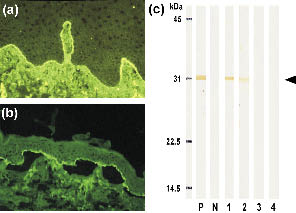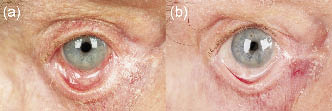Tamara Schumann1, Enno Schmidt2, Nina Booken1, Sergij Goerdt1 and Matthias Goebeler1*
1Department of Dermatology, University Hospital Mannheim, University of Heidelberg, Theodor-Kutzer-Ufer 1-3, DE-68135 Mannheim and 2Department of Dermatology, University of Lübeck, Lübeck, Germany. *E-mail: matthias.goebeler@haut.ma.uni-heidelberg.de
Accepted June 30, 2008.
Sir,
Mucous membrane pemphigoid (MMP) is an often difficult-to-treat autoimmune bullous disease characterized by circulating auto-antibodies targeting the dermo-epidermal junctional zone (1–3). Due to limited disease control and/or severe adverse reactions to glucocorticoids and conventional immunosuppressants, alternative treatment options are frequently needed. We describe here the first successful therapy of refractory MMP with rituximab, a humanized anti-CD20 monoclonal antibody depleting B-lymphocytes (4, 5), that resulted in a complete and persisting remission.
CASE REPORT
A 69-year-old man presented with a 16-month history of conjunctivitis. Six weeks prior to admission he developed blisters on the upper and lower extremities and the shoulders. On physical examination, he presented with reddened conjunctivae and multiple blisters on erythematous skin on the extremities and trunk. Additionally, erosive lesions were seen at the perianal mucosa, while genital and oral mucous membranes were not affected. Histopathological examination of lesional biopsies of the skin and oral mucosa revealed a subepidermal split. Peri-lesional direct immunofluorescence microscopy showed linear deposits of IgG and C3 at the dermo-epidermal junction (Fig. 1a). Indirect immunofluorescence of sodium chloride-split skin revealed circulating IgG auto-antibodies labelling the roof of the artificial blister (titre 1: 80; Fig. 1b). While antibodies against BP180 NC16A could not be detected by enzyme-linked immunoassay (ELISA), Western blot employing keratinocyte supernatant allowed detection of IgG antibodies directed against LAD-1, the extracellular portion of BP180. Furthermore, immunoblotting using recombinant BP180 4575, which represents the C-terminal part of BP180, confirmed the presence of circulating IgG antibodies against that protein (Fig. 1c). Based on these findings, the diagnosis of MMP was made and a therapy with methylprednisolone (0.5 mg kg–1 body weight) and dapsone (100 mg daily) was initiated. Unfortunately, the transaminases increased within the next 3 weeks, which was attributed to dapsone-induced hepatotoxicity; dapsone was therefore discontinued. Since the conjunctivae did not improve and new blisters continued to arise at the integument we began intravenous pulse therapy with dexamethasone (100 mg daily on 3 consecutive days) and cyclophosphamide (500 mg once per course), which was repeated at weeks 2, 5 and 9. Oral methylprednisolone (20 mg daily) was applied between the dexamethasone/cyclophosphamide pulses. With this treatment, the skin and conjunctival lesions slightly improved. However, due to elevating liver enzymes cyclophosphamide application had to be stopped, while 4-weekly dexamethasone pulses were continued. Since the patient’s insulin-dependent diabetes mellitus worsened, while the increased liver enzymes only partially resolved, there was an urgent need to reduce the dose of applied corticosteroids, especially of the methylprednisolone given in between the dexamethasone pulses. In particular, the conjunctival MMP lesions were not sufficiently controlled at that time (Fig. 2a) and levels of circulating auto-antibodies against BP180 were still considerably elevated. We therefore initiated therapy with rituximab (MabThera; Roche, Basel, Switzerland), which has been used successfully for the treatment of autoimmune diseases including refractory pemphigus (4, 5). After obtaining informed written consent, our patient received four courses of intravenous rituximab (375 mg/m2 body surface) at weekly intervals, administered according to published protocols (5, 6). Three-day courses of 100 mg dexamethasone (without cyclophosphamide) were continued while tapering the oral methylprednisolone. Conjunctivae, integument and levels of circulating auto-antibodies successively improved, allowing step-wise prolongation of intervals between dexamethasone courses to 7 weeks. Six months after application of rituximab, dexamethasone pulses could be omitted. At that time-point conjunctivitis was no longer apparent (Fig. 2b), skin lesions had healed completely, leaving post-inflammatory hyperpigmentation and circulating auto-antibodies were undetectable (Fig. 1c). Currently, i.e. 12 months after administration of rituximab and 6 months after the last application of corticosteroids, the patient is still in complete remission and circulating auto-antibodies are not detectable. His diabetes improved and the liver enzymes normalized. Apart from dizziness during the third infusion, rituximab was well tolerated.
Fig. 1. (a) Direct immunofluorescence of a skin biopsy obtained from the buccal mucosa showing linear deposition of C3 at the dermo-epidermal junction. (b) Serum IgG auto-antibodies label the epidermal side of sodium chloride-split skin on indirect immunofluorescence. (c) Western blot analysis using recombinant BP180 4575 confirming the presence of circulating IgG antibodies against that protein. P: positive control serum from an unrelated MMP patient; N: negative control serum from a healthy volunteer; 1–4: patient’s serum obtained at diagnosis before any treatment (1), immediately before (2) or 2 (3) or 6 months (4) after initiation of rituximab. Sera were used at a dilution of 1:20. The immunolabelled BP4575 band is indicated by an arrowhead.
Fig. 2. (a) Involvement of conjunctivae in mucous membrane pemphigoid before application of rituximab. (b) Clearance of conjunctival lesions 6 months after initiation of rituximab therapy.
DISCUSSION
Our case report illustrates the successful use of adjuvant rituximab in a patient suffering from high-risk MMP, which, in contrast to low-risk MMP, is defined as involving ocular, nasopharyngeal, oesophageal, laryngeal and/or genital mucosal membranes (1). While only small controlled trials for MMP are available, a multitude of treatment approaches has been published (7). These mostly include systemic steroids accompanied by immunosuppressants, which, as in our patient, frequently do not control MMP and/or are associated with severe side-effects. A novel strategy for the treatment of autoimmune bullous diseases relies on the depletion of auto-antibody-producing B lymphocytes with the CD20-targeting antibody rituximab. With respect to MMP, application of rituximab has only been documented twice in the literature with limited success. In a 78-year-old patient with advanced high-risk MMP who did not respond to dexamethasone/cyclophosphamide pulse therapy and intravenous immunoglobulins, rituximab resulted in healing of nasopharyngeal and laryngeal lesions but could not prevent progression of conjunctival disease to amaurosis (8). In a 22-year-old woman with high-risk MMP a combination of rituximab, mycophenolate mofetil and systemic glucocorticoids led to partial resolution of mucosal lesions, while preceding therapies with dapsone, methotrexate and systemic steroids could not control the disease (9).
Although immunosuppression with glucocorticosteroids and preceding cyclophosphamide pulses may have contributed to the reduction of circulating auto-antibodies, it is reasonable to assume that disease control and long-term clinical remission were achieved with rituximab therapy. In the case presented here, circulating auto-antibodies against BP180, as measured by immunoblotting using recombinant BP180 4575, became negative 2 months after initiation of rituximab and remained so thereafter. In parallel, conjunctival and skin lesions completely and persistently resolved.
While controlled trials on the use of rituximab in autoimmune bullous diseases including MMP are still pending, an increasing number of case reports and small case series currently covering almost 150 patients provides evidence for the effectiveness of B cell depletion as an adjuvant therapeutic approach in otherwise treatment-refractory disease (10).
Conflict of interest: E.S. and M.G. attended a consensus meeting on the use of rituximab in autoimmune blistering disorders sponsored by Roche. E.S. has received honoraria (less than $5000) from Roche.
References
1. Chan LS, Ahmed AR, Anhalt GJ, Bernauer W, Cooper KD, Elder MJ, et al. The first international consensus on mucous membrane pemphigoid: definition, diagnostic criteria, pathogenic factors, medical treatment, and prognostic indicators. Arch Dermatol 2002; 138: 370–379.
2. Sacher C, Hunzelmann N. Cicatricial pemphigoid (mucous membrane pemphigoid): current and emerging therapeutic approaches. Am J Clin Dermatol 2005; 6: 93–103.
3. Bruch-Gerharz D, Hertl M, Ruzicka T. Mucous membrane pemphigoid: clinical aspects, immunopathological features and therapy. Eur J Dermatol 2007; 17: 191–200.
4. Schmidt E, Hunzelmann N, Zillikens D, Bröcker EB, Goebeler M. Rituximab in refractory autoimmune bullous diseases. Clin Exp Dermatol 2006; 31: 503–508.
5. Schmidt E, Bröcker EB, Goebeler M. Rituximab in treatment-resistant autoimmune blistering skin disorders. Clin Rev Allergy Immunol 2008; 34: 56–64.
6. Hertl M, Zillikens D, Borradori L, Bruckner-Tuderman L, Burckhard H, Eming R et al. Recommendations for the use of rituximab (anti-CD20 antibody) in the treatment of autoimmune bullous skin diseases. J Dtsch Dermatol Ges 2008; 6: 366–373.
7. Kirtschig G, Murrell D, Wojnarowska F, Khumalo N. Interventions for mucous membrane pemphigoid and epidermolysis bullosa acquisita. Cochrane Database Syst Rev 2003; 1: CD004056.
8. Schmidt E, Seitz CS, Benoit S, Bröcker EB, Goebeler M. Rituximab in autoimmune bullous diseases: mixed responses and adverse effects. Br J Dermatol 2007; 156: 352–356.
9. Taverna JA, Lerner A, Bhawan J, Demierre MF. Successful adjuvant treatment of recalcitrant mucous membrane pemphigoid with anti-CD20 antibody rituximab. J Drugs Dermatol 2007; 6: 731–732.
10. Schmidt E, Goebeler M. CD20-directed therapy in autoimmune diseases involving the skin: role of rituximab. Expert Rev Dermatol 2008; 3: 259–278.





